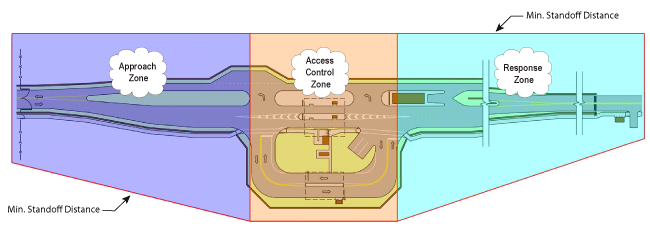ECF Zones
| Zone |
Location |
Goals |
| Safety |
Extends in all directions beyond passive and active barriers. |
Protect assets and personnel from explosions. |
| Approach |
Installation boundary to a point just before the ID checkpoint. |
Reduce speed, sort vehicles, provide stacking room, identify potential threats. |
| Access Control |
A point just before and after the ID checkpoint. |
Identify vehicles and personnel; provide surveillance, random inspection, visitor processing, and rejection capabilities. |
| Response |
A point just after the ID checkpoint to the active vehicle barriers. |
Provide measures to react to and resist a threat. |

As discussed in the UFC, ECFs are subdivided into four zones, each encompassing specific functions and operations. Beginning at the installation property boundary, the zones include: the approach zone, access control zone, response zone, and the safety zone.
The approach zone is the buffer between the external roadway network and the checkpoint. The access control zone is the main body of the ECF. The goal of the access control zone is to monitor vehicles and personnel, provide random inspections, process visitors, and reject unauthorized vehicles.
The response zone extends from the end of the access control zone to the final denial barrier. The safety zone includes the previous three zones and encompasses an additional buffer to protect installation personnel from an explosive vehicle within the ECF area.


